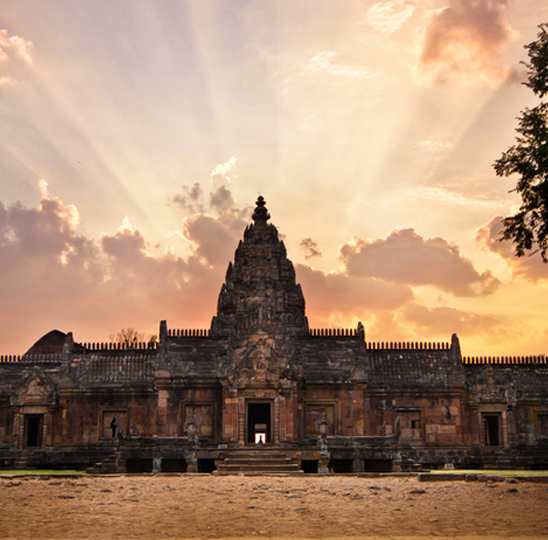Chula geology professor and team of surveyors discovered foreign materials, suspected to be “terracotta”, in the center of Khao Phanom Rung (Phanom Rung Mountain) forest, Buriram Province. The discovery provides significant evidence indicating that Prasat Hin Phanom Rung is not the only ancient building hidden on Khao Phanom Rung.
The discovery was made when Prof. Dr. Santi Pailoplee, lecturer at the Department of Geology, Faculty of Science,
Chulalongkorn University, and his team of surveyors, interested in using remote sensing and geographic information systems to explore archaeology, were exploring the Khao Phanom Rung area. Earlier, they had discovered traces of structures on Khao Phanom Rung, which is one of Thailand’s historical parks dated back thousands of years.
Prof. Dr. Santi explained that in geological terms, Khao Phanom Rung is a Quaternary volcano generated by lava eruption about one million years ago. By surveying the type of rocks in the area, geologists discovered that Khao Phanom Rung was formed by the accumulation of lava from mafic magma. After the lava cooled down, there should only be basaltic rocks on the mountain.
However, during the latest survey at Khao Phanom Rung forest, Prof. Dr. Santi and his research team found, in addition to plenty of basalt rocks, non-basalt materials that resembled weathered cement and were foreign to the area. Ms. Nopphamat Ritthanont, a student from Chulalongkorn University’s Department of Geology, took samples for laboratory evaluation, and used an X-ray Diffractometer (XRD), the team was able to analyze the structural properties of the materials collected without destroying the samples. Lab results showed the materials were composed of quartz or sand deposits, and the majority of what was discovered was clay mineral, namely kaolin clay, which is commonly used today to produce ceramics.
Furthermore, Prof. Dr. Santi and the survey team investigated the plains surrounding Khao Phanom Rung and discovered a newly excavated villager’s well that illustrated the area’s rock hierarchy. The excavated well showed red siltstone at the bottom, white kaolin clay in the middle, and piled at the top was black soil from the breakdown of basalt rocks on Khao Phanom Rung, which later accumulated and covered the entire area. This was significant proof that “the kaolin clay used to build several buildings on Khao Phanom Rung was easily found in the area.”
Prof. Dr. Santi stated that scanning the material in high resolution with a Scanning Electron Microscope (SEM), which clearly showed features of the external structure or surface of the sample in 3D, enormous quartz crystals surrounded by kaolin clay with an uneven surface were found. In comparison to previous studies that showed a difference in kaolin texture in relation to the measured temperature, it may be deduced that the kaolin soil or foreign material discovered on Khao Phanom Rung was calcined at a temperature of around 700 – 800 degrees Celsius. After a thorough study in the laboratory using cutting-edge scientific instruments, it was inferred that the substance is most
likely “terracotta”.
“When we revisited the survey area, we discovered key evidence as the lumps of fresh material had both decayed and non-decayed qualities. The portion that rotted out was white, while the portion that did not had an earthy orange color similar to modern bricks. The clay or brick lumps also contained traces of tiny fibers and holes. The conclusion was, to create such materials, straw and grass clippings were added into the mixture. This evidently supports the assumption that Prasat Hin Phanom
Rung is not the only ancient structure concealed in the center of Khao Phanom Rung forest”, said Prof. Dr. Santi.
Survey Team: Santi Pailoplee, Nopphamat Ritthanont, Kangvol Khatshima, Sombat Mangmeesuksiri, U-tain Wongsathit, Panya Nakauthok, Chakkrit Udonphim, Tamsak Wongmuneevorn, and Sitthichoke Towiriyakul
For the full release and more images, please visit:
https://www.chula.ac.th/en/news/110337/ 